Fujifilm Finepix F770 EXR Review
Fujifilm Finepix F770 EXR Introduction
The Fuji Finepix F770 EXR features a second-generation CMOS implementation of EXR technology first introduced with the F200 EXR. EXR sensors are designed to capture high-resolution, low-noise or high-dynamic-range images, depending on one of three operating modes. Using 16 million photosites, the F770 EXR's sensor can produce high-resolution images up to 16 megapixels or 8 megapixels images with up to 1600% more dynamic range than normal digital cameras can in a single exposure.
Sporting a stabilized Fujinon 20X ultra-wide-angle optical zoom lens, equivalent to 25-500mm in 35mm terms, the Fuji F770 EXR has an almost complete set of manual controls, a rarity among small cameras. The standard PASM modes are all there, plus metering modes including spot, leaving Manual-Focus as the only obviously missing control. The EXR CMOS sensor of the F770 EXR has an ISO range from 100 to 12800, with ISO 3200 achievable at its maximum resolution of 16 megapixels.
Just like its predecessor, the F550 EXR which it resembles, the F770 EXR includes a built-in GPS. In some markets, Fuji sells a model without GPS, the F750 EXR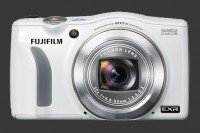
Fujifilm Finepix F750 EXR for less. The high-speed CMOS sensor used in the F770 EXR lets it capture full 1080p HD video and gives it a number of high-speed features including Multi-Frame Noise-Reduction.
Fuji Finepix F770 EXR Key Features
Sensor
- 16 Megapixels CMOS EXR sensor
- ISO range from 100 to 3200 at 12 MP
- ISO 6400 at 8 MP and ISO 12800 at 4 megapixels
- Auto or manual Dynamic-Range: 100%, 200% or 400%
Resolution Priority (EXR-HR)
- 16 Megapixels
- Manual ISO 100-800
- Auto ISO until 400 or 800
- Fixed 100% Dynamic-Range
- 1/4s Minimum Shutter-Speed
Dynamic-Range Priority (EXR-DR)
- 8 Megapixels, Two-Stage read-out
- Auto ISO until 400, 800, 1600 or 3200
- Manual Dynamic-Range, 100% to 1600%
- Automatic Dynamic-Range up to 1600%
- 1/4s Minimum Shutter-Speed
Low-Noise Priority (EXR-SN)
- 8 Megapixels, Binned read-out
- Manual ISO 100-3200
- Auto ISO until 400, 800, 1600 or 3200
- Fixed 100% Dynamic-Range
- 1/4s Minimum Shutter-Speed
Auto EXR
- Automatic resolution selection
- Fixed 8 MP or 4 MP resolution
- Auto ISO only
- Auto Dynamic-Range only
- Auto Exposure without EC
- 1/4s Minimum Shutter-Speed
- Full-Time AF-C only
- Auto WB only
Lens & Optics
- Fujinon 20X ultra-wide-angle optical zoom
- Equivalent to 25-500 in 35mm terms
- F/3.5 - 5.3 fixed aperture
- Aperture simulated by 2 ND filters
- Sensor-shift image stabilization with motion-detection
- 5cm Minimum focus-distance
Exposure & Parameters
- 1/2000 - 8s Shutter-speed range
- PASM Exposure modes
- Multi-segment, average, spot and face-detect metering
- Exposure compensation -2..+2 stops in 1/3 EV increments
- Provia, Velvia, Astia, B&W and Sepia film-simulation modes
- Automatic, Preset and Custom White-Balance
- JPEG, RAW or RAW+JPEG capture
Drive & Focus
- 8 FPS Continuous drive at 16 MP
- 11 FPS Continuous drive at 8 MP
- 8 Frame burst with Pre-Capture at 16 MP
- 16 Frame burst with Pre-Capture at 8 MP
- Auto Exposure Bracketing (AEB), 3 frames, 1/3, 2/3 or 1 EV increments
- Dynamic-Range Bracketing
- Film-Simulation Bracketing
- 2s, 10s or face-detect self-timer
- Single-Shot Autofocus: Center or Automatic point
- Continuous Autofocus: Fixed or Tracking point
- Motion Panorama, 120°, 180°, 360° or circular 360° modes
- Multi-Frame Noise-Reduction
- Multiple-Exposure, 2 frames
Video
- 1920x1080 @ 30 FPS HD movie-mode
- 1280x720 @ 30 FPS HD movie-mode
- 640x480 @ 30 FPS HD movie-mode
- 640x480 @ 80 FPS, 320x240 @ 160 FPS and 320x112 @ 320 FPS High-Speed movie modes
- Single-Shot or Continuous video autofocus
Body & Display
- 3” LCD 460K Pixels
- Built-in flash with manual release
- Auto, Forced-on and Slow-Synchro modes
- Lithium-Ion battery
- SDXC memory
- Built-in GPS
Fujifilm Finepix F770 EXR Suitability - What is it good for?
The Fuji Finepix F770 EXR is one of the most versatile digital camera which falls into the Travel-Zoom category. These are compact models best suited for travel-photography due to their powerful optical zoom lenses. In the case of this digital camera, the lens is equivalent to a 25-500mm lens in 35mm terms. This is a 20X optical zoom which starts at an ultra-wide angle and reaches well into the telephoto category. This wide range of focal-lengths is suitable for nearly all types of subject, including architecture, landscape, portraits, street photography and wild-life.
The triple-mode CMOS sensor of the F770 EXR gives it even more usability than most fixed-lens cameras:
- EXR-HR - High-Resolution mode produces images suitable for large prints up to 20" x 15"
- EXR-DR - Dynamic-Range mode for bright outdoor scenes when contrast often very high
- EXR-SN - Low-Noise mode to produce smoother images in low-light and typical indoor scenes
The full ISO range on this digital camera goes from 100 all the way to 12800. Only ISO 100 to 3200 are available at 16 megapixels. ISO 6400 is available at 8 megapixels and 12800 is available at the sufficient-for-small prints resolution of 4 megapixels. Complex feature-interactions make that not all combinations of ISO, dynamic-range and modes are available, this is discussed in details further in this review.
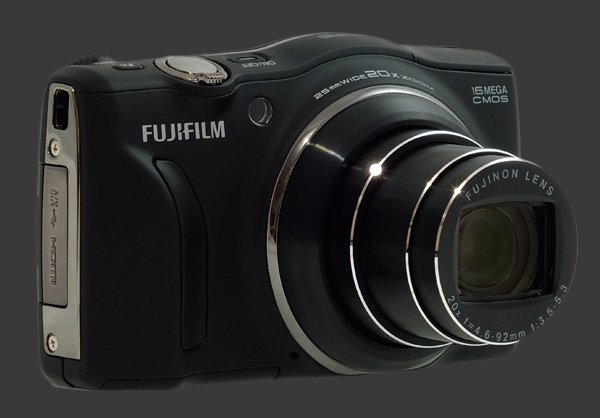
The Fuji F770 EXR is still one of the few fixed-lens digital cameras to feature expanded dynamic range. This is achieved via a special sensor design which allows half of the photosites to be read partway during exposure. This is similar to the taking of multiple exposures for merging images into an HDR image. The difference being that the full exposure exposes for the darkest details. When the sensor is read in this way the dynamic range goes up to 1600%, which equals 4 extra stops, but image resolution drops to 8 megapixels because one half of the photosites are used to complement the other half. Outside of this mode, this digital camera can control its dynamic range between 100% and 400% by using clever processing while producing a 16 megapixels image. Specifically, the F770 EXR can retain 2 more stops of highlight details than what is usually possible. The trade-off is that the extra dynamic range is obtained by boosting sensitivity, therefore, this approach tends to increase noise in darker parts of images.
With a shutter-speed range going from 1/2000s to 8s, the extremes of fast action and low-light may not be well covered, but most situations are. Social photography is the strong point of the Fuji Finepix F770 EXR with high-ISO and an ultra-wide-angle lens which is ideal for indoor parties. Relatively low-light captures are possible with a maximum shutter-speed of 8s which is only available at ISO 100. The maximum shutter-speed drops by one stop for each ISO until 1600 and then once more at ISO 12800, meaning that the lowest light levels can be captured at 1/4s @ ISO 6400 or 1/2s @ ISO 12800. The availability of full manual controls is extremely useful here, as most cameras usually have trouble metering near darkness. The catch is that it must still be able to focus as there is no Manual-Focus mode
The Fuji F770 EXR is capable of dealing with a wide variety of lighting situations in terms of both color and contrast. With its automatic, preset and manual WB options, colors can be accurately captured in any situation. Flexible metering options, including spot-metering, allow the photographer to control how the F770 EXR deals with unevenly-lit scenes. This digital camera is also equipped with several scene modes, divided into normal and advanced modes.. Among normal ones, the Natural Light and Flash mode which takes two pictures of a scene, one with and one without flash, deserves a quick mention.
There are five advanced scene-modes:
- Motion Panorama produces a low-resolution panorama directly in the camera while being moving in a sweeping motion. The field of view must be selected in advance from 120°, 180°, 360° or Cylindrical 360°. This last option indicates that the panorama has to blend at the seems. While the zoom is locked at the wide-angle end, the camera can be swept in any direction.
- Pro Low-Light use 4 images to simulate higher ISO settings while keeping noise low. This is usually called Multi-Frame Noise-Reduction.
- Pro-Focus combines a focused foreground image with an out-of-focus background one to simulate shallow-depth of field. To accomplish this while allowing for camera movements, the field-of-view is reduced, so ultra-wide-angle shooting is not possible.
- Multiple Exposure blends two exposures into one similarly to take photos with a film camera without advancing the film in between. The cool thing with doing this digitally is that Fuji lets you retake the shots as often as needed.
- Individual Shutter 3D creates a single 3D image as an MPO file from two individual shutter-releases. The 3D effect is achieved by making sure both captures show the same subject with a slightly different view-point.
This travel-zoom also captures 1080p HD video using a dedicated button up to 2 GB in size. High-speed video from 80 to 320 FPS are limited to 30s in length. Optical zoom is also available during video-recording, which is not usually allowed by such cameras. Video autofocus is either fixed at the center of the first frame or adjusted continuously.
Fujifilm Finepix F770 EXR Usability - How easy is it to use?
This travel-zoom allows for a secure grip thanks to a small rubberized grip at the front and a protrusion below the mode-dial to prevent the thumb from slipping off. This is a very good design and certainly one of the best ones among compact cameras. There are also 6 rubber dots below the thumb to help with traction. Added security is provided by a standard wrist-strap.
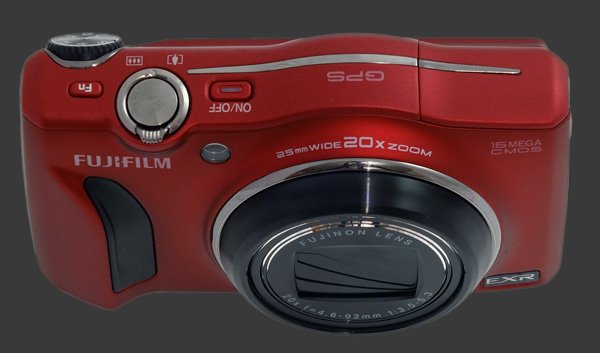
The shutter-release and surrounding zoom controller are very responsive. The two-stage shutter-release has a distinct half-way point with short travel to the full-press. Photographs are taken nearly instantly and the lens zooms rapidly from one end of the zoom-range to the other. Also, all other buttons provide instant feedback, unless the camera is writing an image to memory which is indicated by an orange light. The power button is located on top near the zoom controller. It is flush with the surface to prevent accidental activation.
New to the F770 EXR and F7750 EXR is a programmable function button, labelled Fn, not to be confused with the Finepix button, labelled F. The function button is customizable to invoke one of the following 11 functions: ISO, Image Size, Image Quality, RAW, Dynamic Range, Film Simulation, Photometry (Metering), AF Mode, Face Recognition, Face Detection or Landmark Navigator. Notably missing from this list is WB which is sadly not accessible by any direct button or the F menu.
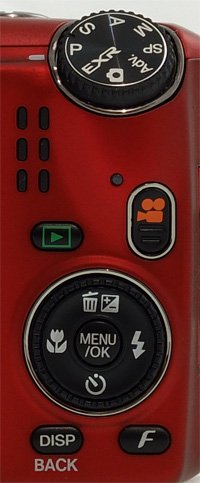 The mode-dial is mounted at a 45° angle so that it is easily accessible from the top or back of the camera. It contains 8 positions. Half of the positions are occupied the standard PASM modes which are found on most cameras with manual-controls. There is a completely automatic mode, labeled with an icon of a camera. The other three positions group several modes together. Selecting a specific mode therefore involves rotating the mode dial and then selecting a specific mode from the menu system. The headline EXR mode, for example, has 4 specific modes: Auto, HR, SN and DR. Auto selects both a scene-mode and an EXR-mode for each photograph. The chosen mode is displayed on the LCD when the shutter is pressed halfway.
The mode-dial is mounted at a 45° angle so that it is easily accessible from the top or back of the camera. It contains 8 positions. Half of the positions are occupied the standard PASM modes which are found on most cameras with manual-controls. There is a completely automatic mode, labeled with an icon of a camera. The other three positions group several modes together. Selecting a specific mode therefore involves rotating the mode dial and then selecting a specific mode from the menu system. The headline EXR mode, for example, has 4 specific modes: Auto, HR, SN and DR. Auto selects both a scene-mode and an EXR-mode for each photograph. The chosen mode is displayed on the LCD when the shutter is pressed halfway.
The remaining camera controls are located on the rear of the Fuji F770 EXR. Most of them are straight forwards:
- Play enters Playback mode
- Video Record starts and stops video recording
- Disp cycles over display modes
- F enters the Finepix menu
Video recording is triggered by the dedicated button alone. There is no mode to set which means the camera is never completely ready for video. Recording starts with a 2 second delay but adequate framing is possible by enabling HD guides using the display button. This is extremely important because HD video has a 16:9 aspect-ratio while images are usually captured with a 4:3 aspect. Since the camera has no video-mode, it cannot know in advance when video will be shot, so it shows the image preview.
There is also a 4-way controller which is surrounded by a thin dial. All directions on the 4-way controller are assigned a function: Up activates exposure-compensation, Right cycles through flash-modes, Down cycles between self-timer (Off, 2s, 10s, Face-Detect) and Left toggles macro mode. With the latest batch of Fuji digital cameras, we are happy to report that the self-timer no longer resets after each use, ending years of frustrations from tripod shooters. The central button is used to activate the menu system and to confirm menu-selection. The dial is used to set exposure parameters, cycle through options and moves between images in Playback mode.
The Finepix menu, invoked by the F button, now has 7 options: ISO, Image Size, Continuous, GPS Setup, Advanced Anti Blur and Film Simulation. Too bad WB and DR are not there as they were in the F200 EXR.
- ISO selects between a large number of options which frequently changes between exposure modes. When permitted, manual selection of ISO goes from 100 to 12800. Automatic ISO selection, when permitted, allows a maximum ISO between 400 and 3200. When changing the ISO to 6400 or 12800, the camera indicates when a change in image size occurs. Since not all ISO settings are always available, changing modes often causes the ISO setting to change too. This is something that constantly needs to be looked after.
- Image Size selects between combinations of resolutions and aspect ratio. There are 3 supported sizes: 16, 8 and 4 megapixels and 3 aspect ratios: 4:3, 3:2 and 16:9. In EXR modes other than Resolution Priority, the 16 megapixels options are not available. In Auto EXR mode, the 16 MP option is replaced by an Auto option for each aspect ratio. This lets the Auto-EXR mode select 16 megapixels when possible and 8 megapixels otherwise.
- Continuous provides access to the usual Single-Shot and Continuous drive modes. There are also 3-frame brackets for Exposure, Film Simulation and Dynamic Range plus a Best Frame Capture mode which grabs a short burst including some taken before the shutter-release is fully pressed..
- GPS Setup invokes a menu which controls GPS functions.
- Advanced Anti Blur is greyed out except in Auto EXR mode. It toggles multi-frame anti-blur which takes a burst of images and automatically blends them into a sharp one.
- Film Simulation selects between Provia, Velvia, Astia, B&W and Sepia. Provia is the natural default setting. Velvia produces high-contrast images with vivid colors. Astia produces lower contrast images with subdued colors.
The Fuji Finepix F770 EXR's capabilities are spread across various modes and things get twisted, particularly in EXR mode. In non-EXR modes, this digital camera normally uses its sensor's HR mode, meaning that all photosites are read simultaneously and each one is turned into a pixel. Although it can be set to output images of 16, 8 or 4 MP, it does not indicate which EXR mode is used when shooting below 16 megapixels. It does give a hint by enabling a different set of dynamic-range options when the flash is off. It would be preferable if things were clearly shown.
P mode is automatic. ISO can be set from 100 to 3200 at full-resolution and up to 12800 at lower-resolutions. Since the Fuji F770 EXR does not actually have a physical aperture, it simulates the reduction of light by sliding one of two neutral-density filters. This implies that changing aperture does not affect the depth-of-field and that, at any point, only three aperture options exist. This is why Shutter-Priority mode does not allow ISO to be fixed: There are too few aperture settings to allow selection of ISO and shutter-speed and still be able to expose the image correctly. Because the Fuji Finepix F770 EXR exposes for the brightest image area, all dynamic-range options are not always available. At ISO 100, only 100% dynamic-range can be used, at ISO 200 options for dynamic-range expand to 200%. Between ISO 400 and 3200, up to 400% dynamic range can be chosen. At ISO 6400 and 12800, only 100% dynamic range is supported.
M mode is fully manual. This mode lets the photographer set aperture, shutter-speed and ISO independently, although the 3 aperture settings do not affect depth-of-field due to the lack of a physical aperture. Still, the Fuji F770 EXR has an excellent exposure latitude considering ISO goes up to 12800 and shutter-speed down to 8s. The thin dial around the 4-way controller is used to change shutter-speed or aperture, depending on which one is highlighted. To change between the two, simply press the Up direction.
Auto is the fully-automatic mode. It does not allow ISO, DR, WB or EC to be selected. It does allow the ISO limit to be set between 400 and 3200. There are 18 scene-modes available, all of them automatic but several allow EC to be set, surely a very welcome improvement for those who use these modes.
EXR mode has 4 sub-modes: Auto, HR (Resolution Priority), SN (Low Noise) and DR (Dynamic Range). Auto-EXR mode is as close to magic as any camera technology ever was. It takes control of the camera, including activating continuous-autofocus, scene-mode recognition, auto image size selection, face-detection and disabling EC, WB and ISO settings. Auto-EXR drains the battery faster though. Still, image aspect ratio, image quality, self-timer and flash-mode can all be set.
HR mode is nearly identical to automatic P mode, the notable difference being that ISO is limited to 800 max. Resolution can be set to either 16, 8 or 4 megapixels with 4:3, 3:2 or 16:9 aspect ratio. It is not clear why 8 MP HR mode would be any different than 8 MP SN mode. SN mode limits resolution to 8 megapixels and the ISO to 3200.Why SN mode cannot use ISO 6400 and 12800 and HR and SN modes have Dynamic-Range fixed at 100% is a mystery.
DR mode allows the selection of dynamic-range from 100% to 1600%, which represents 4 extra stops beyond the F770 EXR's base dynamic-range. Resolution is limited to 8 megapixels and only automatic ISO settings (400 to 3200 max) can be selected. White-balance, exposure-compensation, macro mode and self-timers can be set as well. The Flash-mode is fixed to off though. Now, it is expected that expanded dynamic-range not be available at high-ISO due to high noise-levels, however it is too bad that DR mode is mutually exclusive with manual controls and that shutter-speeds slower than 1/4s are not achievable in this mode.
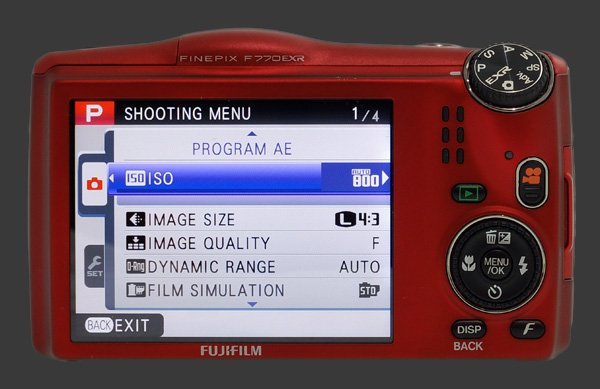
The full menu of the Fuji Finepix F770 EXR is organized in two tabs, one for the camera menu and the other for the setup menu. The 3" LCD screen is excellent with a new slim design that increases contrast and dynamic-range. The anti-reflective coating really does its job well. With a resolution of 460K pixels, images on the screen are sharp and motion is fluid. The preview is always bright and does not simulate exposure changes except when dialing EC.
This camera is well constructed with a sturdy plastic body. Both battery and memory are found behind the only compartment door. The battery is held in place with a latch so that it does not fall out while changing memory cards. Another nice touch is that the latch is colored yellow, as is one side of the battery to know which way to insert it. There is a metal tripod-mount which is neither inline with the lens nor with the center of the camera.
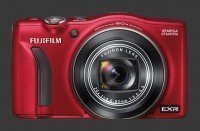 |
Please Support Neocamera
All information on Neocamera is provided free of charge yet running this website is a huge endeavor. Purchases made via affiliate links found throughout the site help keep it running and up-to-date. There is no additional cost to you, so please consider buying via these links to our affilates:
If you found any information on this site valuable and did not purchase via our affiliate links, please considering donating via PayPal:
Any amount will be greatly appreaciated. Thank you for your support!
Fujifilm F770 EXR Highlights

Sensor-Size: 6 x 5mm

Actual size when viewed at 100 DPI
| 16 Megapixels Travel Zoom | ISO 100-3200 |
| 20X Ultra-Wide Optical Zoom | Shutter 1/2000-8s |
| Built-in Stabilization | Full manual controls |
| 1920x1080 @ 30 FPS Video Recording | Custom white-balance |
| 3" LCD 460K Pixels | Spot-Metering |
| Lithium-Ion Battery | |
| Secure Digital Extended Capacity, Internal Memory |
Updates
2025.01.18

Fujifilm GFX 2025 Lens Roundup
Lens Review roundup of Fujifilm GFX Medium-Format lenses. Quality, performance and handling of the GF20-35mm F/4R WR, GF30mm F/3.5 Tilt-Shift and the GF55mm F/1.7.
2024.11.18

Best 2024 Photography Gifts for Every Budget
Great gifts for photographers and photo enthusiasts selected for every budget among the best products of 2024.
2024.08.07

Eye Protection Tips for Professional Photographers
The four main considerations for professional photographers regarding eyewear.
2024.07.14

Fujifilm X100VI Review
Flagship fixed-lens compact digital camera with a 40 MP sensor and Image-Stabilization, a first for the series. Retro design featuring dual control-dials, plus direct ISO, Shutter-Speed and EC dials. Its hybrid viewfinder can switch between EVF and OVF mode.
2024.05.09

Fujifilm GFX100 II Review
Flagship 102 Megapixels Medium-Format Mirrorless Digital Camera with 8-Stop 5-Axis IBIS, 8 FPS Drive, 8K Video and 400 MP Super-Resolution capture in a weatherproof and freezeproof body with dual control-dials and dual memory-card slots.
2024.04.03

Fujifilm X-T5 Review
Newest Fujifilm flagship boasting a 40 MP APS-C sensor, 5-axis IBIS with 7-stop efficiency, 15 FPS continuous drive, 6.2K Video capture, dual control-dials and dual SDXC UHS-II slots in a sturdy weatherproof and freezeproof body.
2023.11.20

Best Digital Cameras of 2023
Find out which are the Best Digital Cameras of 2023. All the new Mirrorless Digital Cameras from entry-level to high-end professional.
2023.07.10

Fujifilm X-H2 Review
40 Megapixels APS-C Hybrid Mirrorless Digital Camera with 7-stop IBIS. Fastest shutter ever and 8K video capture. Large builtin EVF with 0.8X magnification and 5.8 MP, plus an Eye-Start Sensor. Packed with features and large number of controls in a weatherproof and freezeproof body.
2023.05.07

Sony FE 20-70mm F/4G Review
Review of the unique Sony FE 20-70mm F/4G lens. The optical zoom of this lens spans ultra-wide-angle and medium focal-length coverage, making it one of the most versatile Full-Frame lenses on the market.
2023.01.15

Huion Inspiroy Dial 2 Review
Review of the Huion Inspiroy Dial 2 tablet, a medium sized drawing surface with dual dials and customizable buttons. Connects via USB-C or Bluetooth 5.0 with Windows, Linux and Android support.
2022.12.08

How to Pack for a Photo Trip
Find out how to pack for a travel photography trip, carry your gear safely while meeting airline regulations.
2022.11.13

Best Digital Cameras of 2022
The best digital cameras of 2022. A short list of the most outstanding models in their respective categories. Choose one for yourself or as a gift.














